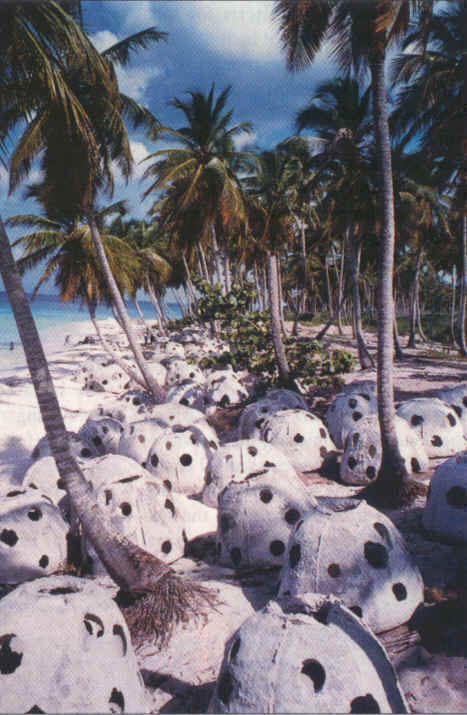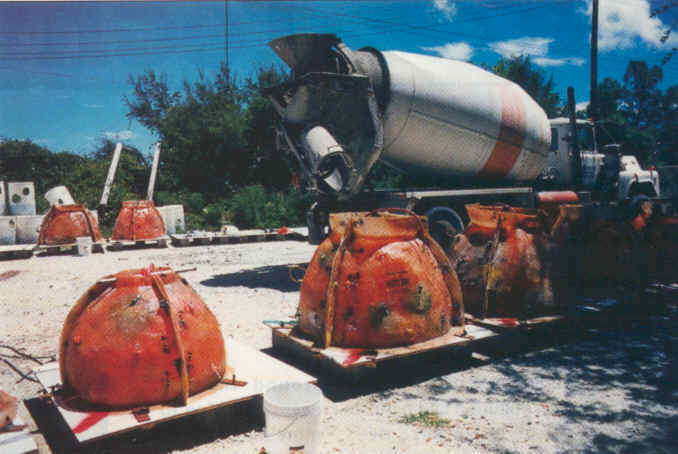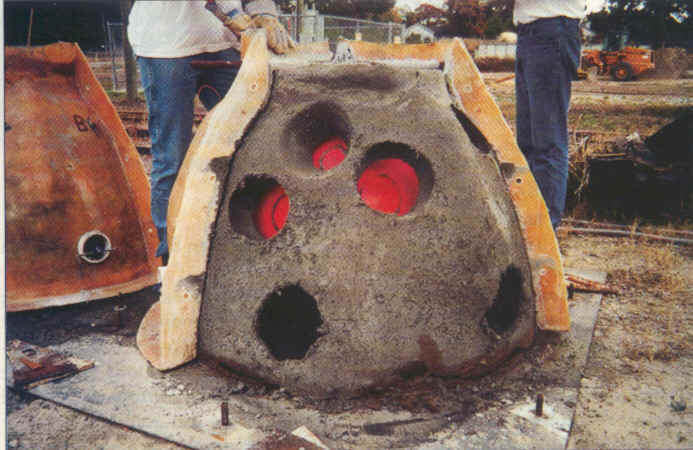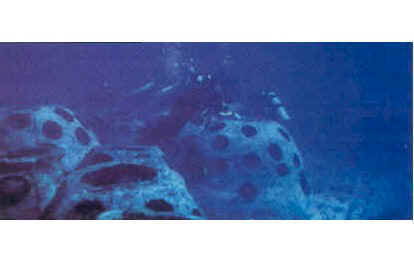

Help for homeless sea creatures
Precast concrete units rebuild the aquatic environment
Human recreational activity,
pollution and natural disasters have destroyed many natural coral reef systems in the
world's oceans. Where natural reefs can't rebuild themselves quickly enough to prevent
damage to beaches and fish populations, one environmentally sound solution is to build
artificial reefs with Reef Balls, dome-shaped hollow concrete balls with holes in them
that mimic natural coral reefs.
Some ready-mixed and precast concrete producers have gained goodwill
and an outlet for waste concrete by becoming, or partnering with, Reef-Ball licensees.
Tim Guscette, plant manager at Southdown Inc.'s Concrete Products
Division in Sarasota, Fla. (formerly Florida Mining and Materials), notes that it's an
excellent way to put to good use ends of loads and rejected loads the company would
otherwise have to dispose of. This is because producers like Guscette can cast Reef Balls,
somewhat rough and imperfect by design, with almost any waste concrete, as long as it's
adjusted with the required admixtures and remixed. "It's a great public relations
thing for us to do, as well as a positive thing for the environment," says Guscette.
Beach balls to Reef Balls
Often, artificial reefs are sunken ships, tires, old train cars or crumbled bridges. Todd
Barber, now president of the Reef Ball Development Group Ltd. (RBDG), a volunteer
environmental organization, got tired of scuba diving around these trash heaps. Wishing to
see more long-lasting, environmentally friendly reefs, he came up with the idea for Reef
Balls.
Barber and his buddies began by trying to cover beach balls with
chicken wire and concrete with the plan of floating them out to sea, popping the balls and
letting the shells sink to the bottom. This is essentially how the Reef Ball works.
A Reef Ball is made by placing concrete into a fiberglass mold that
contains a central inflatable buoy surrounded by inflatable balls of various sizes around
which concrete is placed, forming the holes. Though the basic shape is uniform, no two
Reef Balls are identical because the holes are placed and sized manually on each form. The
internal buoy can be left in place to provide flotation for towing the ball out to sea by
boat, then deflated slowly to allow a controlled descent for precise placement by divers.
This placement method makes repairs to existing natural reefs possible. It's also possible
to deploy Reef Balls by less precise methods such as dumping them off a barge, dropping
them from a crane and even flying them out to sea by helicopter.
Reef Balls represent only one of the reef-building products available.
Pallet Balls, Bay Balls, Lo-Pro Balls and Oyster Balls offer variations on the size and
shape. Miniature 6-inch model Reef Balls are also available and make good reefs in
saltwater aquariums.
 All
photos courtesy Reef Ball Development Group Ltd.
All
photos courtesy Reef Ball Development Group Ltd.
Reef Balls awaiting deployment far a beach
restoration project in the Dominican Republic.
Why concrete?
The use of concrete to construct artificial reefs offers several
advantages. Reef Balls are heavy enough to be stable on the sea floor (they have withstood
hurricanes without moving) yet provide multiple entrances and internal cavities for
shelter. Concrete contains no toxins and the surface of the balls can be rough and
textured to enhance marine growth. Reef Balls carefully designed for the local environment
should last hundreds of years.
The concrete mix design for Reef Balls is tailored for each location
and application. Design criteria for saltwater deployment might include:
• 4500-psi compressive strength
• Type II Portland cement
•Microsilica ( 9% to 10% of the cement volume)
• 7- to 9-inch slump obtained with a high-range water-reducing admixture
(superplasticizer)
• Sugar water surface retarder on mold surfaces
• 4% air entrainment
• Polypropylene fibers
The microsilica helps to create highstrength, abrasion-resistant
concrete with low permeability. Adding microsilica also lowers the initial pH of the
concrete, promoting the growth of desired marine life such as larval corals. It reacts
with the hydration byproduct, calcium hydroxide, to reduce the surface pH from around 12
for normal concrete to one closer to that of natural sea water. Although this reduction
would happen normally under water over three to six months, the initially high pH would
kill some marine species and allow less-desirable resistant species such as barnacles to
take over.
The superplasticizer makes the concrete fluid enough to flow around all
the inflated objects. The producer sprays sugar water onto the mold surfaces before
casting to retard surface setting. This keeps the outside half inch of the concrete from
setting; the producer can then expose the aggregate by rinsing the surface with a hose.
The resulting uneven surface texture encourages the growth of algae, barnacles and coral.
An air-entraining agent may also be used for its surface texture
benefits. It creates tiny pockets in the concrete that pit the Reef Ball's surface,
offering miniature marine organisms places to easily attach themselves.
Reef Balls normally contain no reinforcing steel because iron is
biologically active, serving as a nutrient for algae, which outgrows the more desirable
hard corals. When rebar is necessary, a calcium nitrite-based corrosion inhibitor must be
used. The producer may use polypropylene
fibers to reduce microcracks that can occur in molds with inflatable parts in hot weather
or where the mold temperature is uneven (as when the sun shines on one side).
While most Reef Balls are used in saltwater applications, they are
occasionally used in fresh water over sandy areas to provide a place for fish to spawn.
For freshwater applications, a standard concrete mix with only the superplasticizer added
is suitable. The microsilica, entrained air and surface retarder are not necessary.


Reef Ball molds and demolding of a Reef Ball reveals its
Swiss-cheese-like holes and internal inflated balloon.
Authorized manufacturers
RBDG sells the molds, provides clients with concrete specifications,
helps clients through the permitting process, and licenses manufacturers who market, make
and transport the balls.
Often, producers work in partnership with RBDG's other authorized firms, providing a place
to build the balls and donating materials while volunteers provide the labor. Barber notes
that while RBDG is always looking for additional licensees, it's essential that interested
parties exhibit a genuine concern for the environment before they will be seriously
considered.
Roman Stone Construction Co. in Bay Shore, NY, now in its 95th year of
precast pipe operations, has also become a licensed Reef Ball manufacturer. General
Manager Tom Montalbine believes concrete is a good choice for reef building.
"Concrete and concrete production in general
could be considered environmentally sound because the raw materials are all natural,"
he says. Montalbine's personal interest in scuba diving gives him an extra reason to
appreciate the work of the RBDG and helped spark his initial interest in Reef Balls.
RBDG uses the royalties it receives from its authorized manufacturers
to help fund the Reef Ball Foundation, a nonprofit group that supplies free molds and
support to other nonprofit and research groups who wish to study or help create Reef Ball
reefs. Reef Balls have been deployed off all U.S. coasts, and international use is
widespread and growing. -M. Wynne Palmer

In only one year, significant sponge and soft coral growth
can be realized, as shown on this Bay Ball in the Florida Keys (left). Diver look at
freshly deployed Reef Balls in Cancun, Mexico (right).
Web Link - Extensive information about Reef Balls is also available on the Reef Ball Development Group's Web site: www.reefball.org